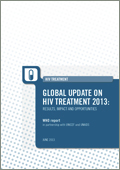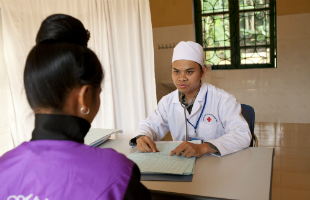
WHO releases “Global treatment update 2013: results, impact and opportunities” demonstrating the latest reporting progress in antiretroviral therapy (ART) achieved in low- and middle-income countries. It shows 9.7 million people received ART at the end of 2012, and outlines challenges and solutions required to achieve 2015 goals and beyond.
The massive global expansion of access to HIV treatment has transformed not only the HIV epidemic but the entire public health landscape, demonstrating that the right to health can be realized even in the most trying of circumstances.
Executive summary
This publication reports on the progress being made in the global scale-up in the use of antiretroviral (ARV) medicines in low- and middle-income countries, the challenges that are being overcome or that await solutions and the opportunities for building on the achievements of the past decade.
Chapter 1 provides new data on the latest developments in the global treatment effort, highlighting positive trends as well as aspects that require improvement. It also discusses the key recommendations of the 2013 WHO Consolidated Guidelines on the Use of Antiretroviral Drugs for Treating and Preventing HIV Infection, which are designed to take advantage of the multiple benefits of antiretroviral therapy (ART) for treating and preventing HIV infection.
Chapter 2 summarizes the impact of the scale-up in reducing AIDS-related mortality and new HIV infections.
Excerpt: Increasing testing uptake in Viet Nam

Injecting drug use is the main driver of Viet Nam’s HIV epidemic. Testing uptake among people who inject drugs, however, is low. Many people living with HIV, especially people who inject drugs, initiate ART late, with most starting ART with CD4 counts <100 cells/mm3. In 2012, the Ministry of Health started a pilot Treatment 2.0 programme in Dien Bien and Can Tho provinces in which HIV testing, counselling and treatment follow-up services were decentralized to commune health stations. This enabled the communes to reach people who inject drugs but who previously had been unable or reluctant to use district-level services.
The new decentralized model, combined with outreach services, appears to be effective in some geographical areas in promoting HIV testing and counselling and in increasing ART uptake in key populations such as people who inject drugs. However, people who inject drugs still face stigma, discrimination and various structural barriers when seeking to use HIV services.
Chapter 3 examines the sequence of steps in the continuum of care from HIV diagnosis to successful provision of ART services and outlines key supportive innovations. Finally,
Chapter 4 discusses the implications and anticipated impact of the new 2013 WHO ARV guidelines.
